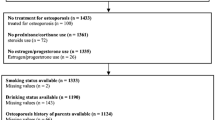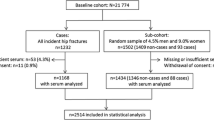Abstract
Summary
In a large cohort of older women, we investigated the relationships that different forms of vitamin E may have with bone turnover markers and bone mineral density (BMD). We found a suggestive positive association between serum alpha-tocopherol and BMD at the femoral neck, but no other clinically relevant observations.
Introduction
Vitamin E has anti-oxidant and anti-inflammatory properties hypothesized to benefit bone, but limited studies exist regarding its homologues. We examined circulating and dietary α- and γ-tocopherols with bone turnover markers (BTMs) and bone mineral density (BMD), and the role of inflammation in this relationship.
Methods
We performed two cross-sectional analyses from two visits (V2, 1997–1999, n = 3883; V3, 2007–2011, n = 2130) of the Aberdeen Prospective Osteoporosis Screening Study. Dietary and supplement intakes by food frequency questionnaire were assessed at both visits. V2 BTMs (urinary free pyridinoline and deoxypyridinoline, serum N-terminal propeptide of type 1 collagen) and V3 serum α- and γ-tocopherols, inflammatory markers (interleukin-6 [IL-6], serum amyloid A [SAA], high-sensitivity C-reactive protein [hs-CRP], E-selectin) and dual X-ray absorptiometry BMD at the femoral neck and lumbar spine were collected. Food sources of tocopherol homologues and diet-serum correlations were determined. The relationships between dietary tocopherols and BTMs (V2), and dietary and serum tocopherols with BMD (V3) were examined by multivariable regression (adjusting for age, cholesterol, inflammatory markers, carotenoids, body mass index, physical activity level, alcohol intake, smoking status and national deprivation category).
Results
Serum γ-tocopherol was associated with increasing concentrations of hs-CRP, SAA and E-selectin (P-trend all <0.0001), while α-tocopherol was associated with decreasing concentrations of IL-6 and hs-CRP (P-trend all <0.001). Controlling for covariates, serum α-tocopherol was positively associated with BMD at the femoral neck (β = 0.002, P = 0.04) among those not reporting vitamin E supplementation.
Conclusion
We did not find biologically meaningful results between dietary and tocopherol homologues with BTMs or BMD.
Similar content being viewed by others
References
Lane NE (2006) Epidemiology, etiology, and diagnosis of osteoporosis. Am J Obstet Gynecol. doi:10.1016/j.ajog.2005.08.047
Pfeilschifter J, Köditz R, Pfohl M, Schatz H (2002) Changes in proinflammatory cytokine activity after menopause. Endocr Rev 23:90–119. doi:10.1210/er.23.1.90
Jiang Q (2014) Natural forms of vitamin E: metabolism, antioxidant, and anti-inflammatory activities and their role in disease prevention and therapy. Free Radic Biol Med 72C:76–90. doi:10.1016/j.freeradbiomed.2014.03.035
Michaëlsson K, Wolk A, Byberg L et al (2014) Intake and serum concentrations of α-tocopherol in relation to fractures in elderly women and men: 2 cohort studies. Am J Clin Nutr 99:107–114. doi:10.3945/ajcn.113.064691
Melhus H, Michaëlsson K, Holmberg L et al (1999) Smoking, antioxidant vitamins, and the risk of hip fracture. J Bone Miner Res 14:129–35. doi:10.1359/jbmr.1999.14.1.129
Maggio D, Barabani M, Pierandrei M et al (2003) Marked decrease in plasma antioxidants in aged osteoporotic women: results of a cross-sectional study. J Clin Endocrinol Metab 88:1523–1527. doi:10.1210/jc.2002-021496
Mata-Granados JM, Cuenca-Acebedo R, Luque de Castro MD, Quesada Gómez JM (2013) Lower vitamin E serum levels are associated with osteoporosis in early postmenopausal women: a cross-sectional study. J Bone Miner Metab 31:455–60. doi:10.1007/s00774-013-0432-2
Hermizi H, Faizah O, Ima-Nirwana S et al (2009) Beneficial effects of tocotrienol and tocopherol on bone histomorphometric parameters in Sprague–Dawley male rats after nicotine cessation. Calcif Tissue Int 84:65–74. doi:10.1007/s00223-008-9190-x
Norazlina M, Hermizi H, Faizah O et al (2010) Vitamin E reversed nicotine-induced toxic effects on bone biochemical markers in male rats. Arch Med Sci 6:505–512. doi:10.5114/aoms.2010.14460
Urban K, Höhling HJ, Lüttenberg B et al (2012) An in vitro study of osteoblast vitality influenced by the vitamins C and E. Head Face Med 8:25. doi:10.1186/1746-160X-8-25
Kontush A, Finckh B, Karten B et al (1996) Antioxidant and prooxidant activity of alpha-tocopherol in human plasma and low density lipoprotein. J Lipid Res 37:1436–1448
Wagner KH, Kamal-Eldin A, Elmadfa I (2004) Gamma-tocopherol—an underestimated vitamin? Ann Nutr Metab 48:169–188. doi:10.1159/000079555
Wolf RL, Cauley JA, Pettinger M et al (2005) Lack of a relation between vitamin and mineral antioxidants and bone mineral density: results from the Women’s Health Initiative. Am J Clin Nutr 82:581–588
Hamidi MS, Corey PN, Cheung AM (2012) Effects of vitamin E on bone turnover markers among US postmenopausal women. J Bone Miner Res 27:1368–80. doi:10.1002/jbmr.1566
Ames BN, Shigenaga MK, Hagen TM (1993) Oxidants, antioxidants, and the degenerative diseases of aging. Proc Natl Acad Sci U S A 90:7915–22. doi:10.1073/pnas.90.17.7915
Fujita K, Iwasaki M, Ochi H et al (2012) Vitamin E decreases bone mass by stimulating osteoclast fusion. Nat Med 18:589–94. doi:10.1038/nm.2659
Berdnikovs S, Abdala-Valencia H, McCary C et al (2009) Isoforms of vitamin E have opposing immunoregulatory functions during inflammation by regulating leukocyte recruitment. J Immunol 182:4395–4405. doi:10.4049/jimmunol.0803659
Bermudez EA, Rifai N, Buring JE et al (2002) Relation between markers of systemic vascular inflammation and smoking in women. Am J Cardiol 89:1117–9
Apostolopoulos V, de Courten MPJ, Stojanovska L, et al. (2015) The complex immunological and inflammatory network of adipose tissue in obesity. Mol Nutr Food Res. doi:10.1002/mnfr.201500272
Lumeng CN (2013) Innate immune activation in obesity. Mol Aspects Med 34:12–29. doi:10.1016/j.mam.2012.10.002
Garton MJ, Torgerson DJ, Donaldson C et al (1992) Recruitment methods for screening programmes: trial of a new method within a regional osteoporosis study. BMJ 305:82–4. doi:10.1136/bmj.307.6896.99
Duthie GG (1999) Determination of activity of antioxidants in human subjects. Proc Nutr Soc 58:1015–1024. doi:10.1017/S0029665199001330
Bolton-Smith C, Casey CE, Gey KF et al (1991) Antioxidant vitamin intakes assessed using a food-frequency questionnaire: correlation with biochemical status in smokers and non-smokers. Br J Nutr 65:337–46. doi:10.1079/BJN19910094
Tunstall-Pedoe H, Smith WC, Crombie IK, Tavendale R (1989) Coronary risk factor and lifestyle variation across Scotland: results from the Scottish Heart Health Study. Scott Med J 34:556–560
Department of Health (1991) Dietary reference values for food energy and nutrients for the United Kingdom. HMSO, London, United Kingdom
McLoone P (1994) Carstairs scores for Scottish postcode sectors from the 1991 census. University of Glasgow, Glasgow, United Kingdom
Willett WC, Howe GR, Kushi LH (1997) Adjustment for total energy intake in epidemiologic studies. Am J Clin Nutr 65:1220S–1228S, discussion 1229S–1231S
Wood AD, Strachan AA, Thies F et al (2014) Patterns of dietary intake and serum carotenoid and tocopherol status are associated with biomarkers of chronic low-grade systemic inflammation and cardiovascular risk. Br J Nutr 112:1341–1352. doi:10.1017/S0007114514001962
Kayden HJ, Traber MG (1993) Absorption, lipoprotein transport, and regulation of plasma concentrations of vitamin E in humans. J Lipid Res 34:343–358
Nazrun AS, Norazlina M, Norliza M, Ima Nirwana S (2010) Comparison of the effects of tocopherol and tocotrienol on osteoporosis in animal models. Int J Pharmacol 6:561–568. doi:10.3923/ijp.2010.561.568
Singh U, Jialal I (2004) Anti-inflammatory effects of alpha-tocopherol. Ann N Y Acad Sci 1031:195–203. doi:10.1196/annals.1331.019
White E, Kristal A, Shikany J et al (2001) Correlates of serum α-and γ-tocopherol in the Women’s Health Initiative. Ann Epidemiol 11:136–144
Block G, Jensen CD, Dalvi TB et al (2009) Vitamin C treatment reduces elevated C-reactive protein. Free Radic Biol Med 46:70–77. doi:10.1016/j.freeradbiomed.2008.09.030
Bruunsgaard H, Poulsen HE, Pedersen BK et al (2003) Long-term combined supplementations with alpha-tocopherol and vitamin C have no detectable anti-inflammatory effects in healthy men. J Nutr 133:1170–1173
Jiang Q, Ames BN (2003) Gamma-tocopherol, but not alpha-tocopherol, decreases proinflammatory eicosanoids and inflammation damage in rats. FASEB J 17:816–822. doi:10.1096/fj.02-0877com
Jordan JM, De Roos AJ, Renner JB et al (2004) A case–control study of serum tocopherol levels and the alpha- to gamma-tocopherol ratio in radiographic knee osteoarthritis: the Johnston County Osteoarthritis Project. Am J Epidemiol 159:968–77. doi:10.1093/aje/kwh133
Wimalawansa SJ (2010) Nitric oxide and bone. Ann N Y Acad Sci 1192:391–403. doi:10.1111/j.1749-6632.2009.05230.x
Iwaniec UT, Turner RT, Smith BJ et al (2013) Evaluation of long-term vitamin E insufficiency or excess on bone mass, density, and microarchitecture in rodents. Free Radic Biol Med 65:1209–1214. doi:10.1016/j.freeradbiomed.2013.09.004
Muhammad N, Luke DA, Shuid AN et al (2013) Tocotrienol supplementation in postmenopausal osteoporosis: evidence from a laboratory study. Clinics 68:1338–43. doi:10.6061/clinics/2013(10)08
Chuin A, Labonté M, Tessier D et al (2009) Effect of antioxidants combined to resistance training on BMD in elderly women: A pilot study. Osteoporos Int 20:1253–1258. doi:10.1007/s00198-008-0798-5
Pye SR, Reid DM, Adams JE et al (2006) Radiographic features of lumbar disc degeneration and bone mineral density in men and women. Ann Rheum Dis 65:234–238. doi:10.1136/ard.2005.038224
Handelman GJ, Machlin LJ, Fitch K et al (1985) Oral alpha-tocopherol supplements decrease plasma gamma-tocopherol levels in humans. J Nutr 115:807–813
Clowes JA, Hannon RA, Yap TS et al (2002) Effect of feeding on bone turnover markers and its impact on biological variability of measurements. Bone 30:886–890. doi:10.1016/S8756-3282(02)00728-7
Traber MG, Leonard SW, Bobe G, et al. (2015) a -Tocopherol disappearance rates from plasma depend on lipid concentrations: studies using deuterium-labeled collard greens in younger and older adults. doi:10.3945/ajcn.114.100966
Macdonald HM, New SA, Golden MHN et al (2004) Nutritional associations with bone loss during the menopausal transition: evidence of a beneficial effect of calcium, alcohol, and fruit and vegetable nutrients and of a detrimental effect of fatty acids. Am J Clin Nutr 79:155–65
Acknowledgments
This study was supported by the Foods Standards Agency and the UK Department of Health (grant number N05086) and the Scottish Funding Council. We are grateful for funding from the Scottish Government’s Rural and Environmental Science and Analytical Services (RESAS) Food, Land and People Programme. Any views expressed are the authors’ own; none of the funders had a role in design, analysis or writing of the present study.
Author information
Authors and Affiliations
Corresponding author
Ethics declarations
Conflicts of interest
None.
Electronic supplementary material
Below is the link to the electronic supplementary material.
Online Resource 1
(DOCX 12 kb)
Online Resource 2
(DOCX 12 kb)
Online Resource 3
(DOCX 14 kb)
Online Resource 4
(DOCX 21 kb)
Rights and permissions
About this article
Cite this article
Yang, T.C., Duthie, G.G., Aucott, L.S. et al. Vitamin E homologues α- and γ-tocopherol are not associated with bone turnover markers or bone mineral density in peri-menopausal and post-menopausal women. Osteoporos Int 27, 2281–2290 (2016). https://doi.org/10.1007/s00198-015-3470-x
Received:
Accepted:
Published:
Issue Date:
DOI: https://doi.org/10.1007/s00198-015-3470-x




